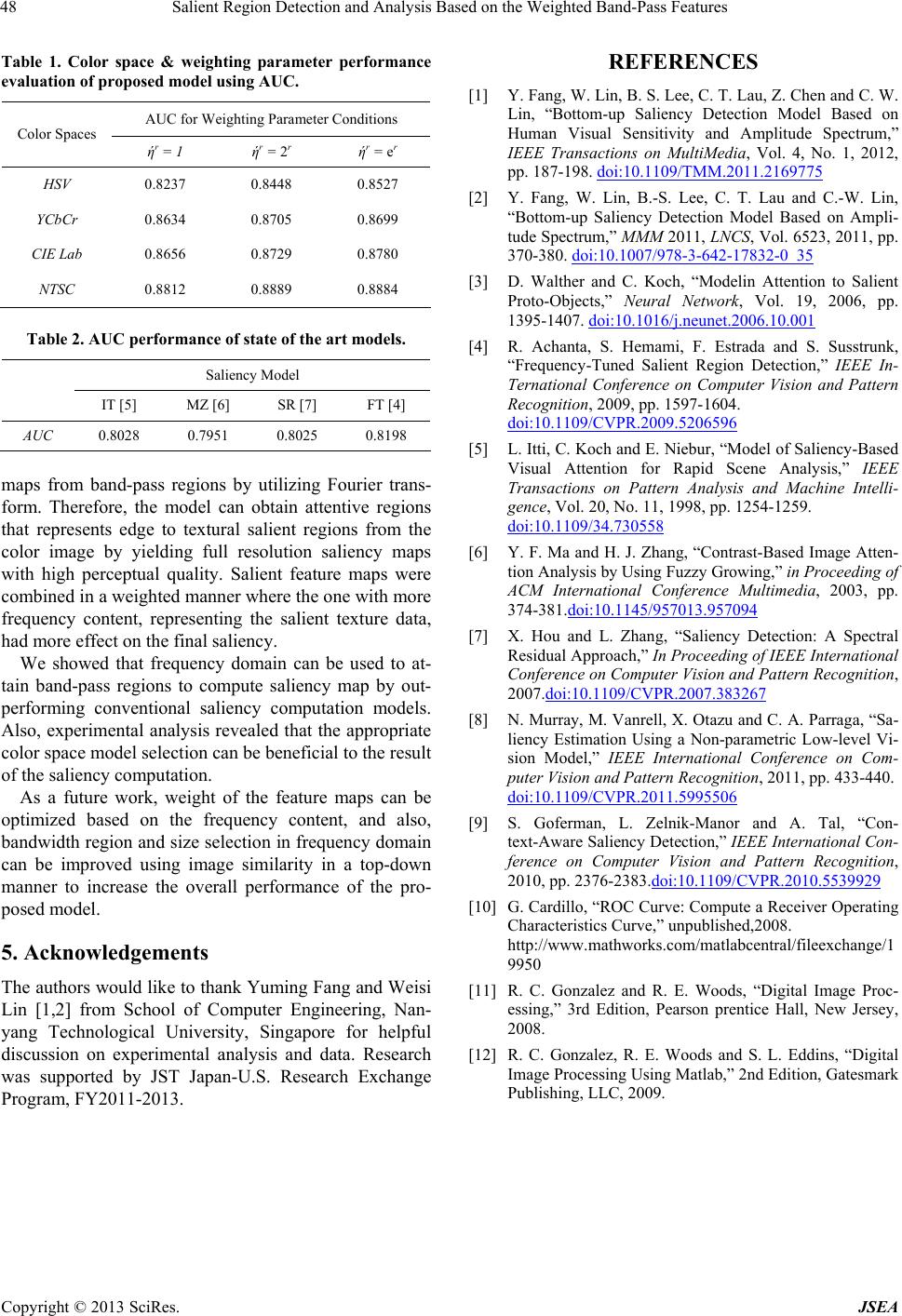
Salient Region Detection and Analysis Based on the Weighted Band-Pass Features
48
Table 1. Color space & weighting parameter performance
evaluation of proposed model using AUC.
AUC for Weighting Parameter Conditions
Color Spaces
ήr = 1 ήr = 2r ήr = er
HSV 0.8237 0.8448 0.8527
YCbCr 0.8634 0.8705 0.8699
CIE Lab 0.8656 0.8729 0.8780
NTSC 0.8812 0.8889 0.8884
Table 2. AUC performance of state of the art models.
Saliency Model
IT [5] MZ [6] SR [7] FT [4]
AUC 0.8028 0.7951 0.8025 0.8198
maps from band-pass regions by utilizing Fourier trans-
form. Therefore, the model can obtain attentive regions
that represents edge to textural salient regions from the
color image by yielding full resolution saliency maps
with high perceptual quality. Salient feature maps were
combined in a weighted manner where the one with more
frequency content, representing the salient texture data,
had more effect on the final saliency.
We showed that frequency domain can be used to at-
tain band-pass regions to compute saliency map by out-
performing conventional saliency computation models.
Also, experimental analysis revealed that the appropriate
color space model selection can be beneficial to the result
of the saliency computation.
As a future work, weight of the feature maps can be
optimized based on the frequency content, and also,
bandwidth region and size selection in frequency domain
can be improved using image similarity in a top-down
manner to increase the overall performance of the pro-
posed model.
5. Acknowledgements
The authors would like to thank Yuming Fang and Weisi
Lin [1,2] from School of Computer Engineering, Nan-
yang Technological University, Singapore for helpful
discussion on experimental analysis and data. Research
was supported by JST Japan-U.S. Research Exchange
Program, FY2011-2013.
REFERENCES
[1] Y. Fang, W. Lin, B. S. Lee, C. T. Lau, Z. Chen and C. W.
Lin, “Bottom-up Saliency Detection Model Based on
Human Visual Sensitivity and Amplitude Spectrum,”
IEEE Transactions on MultiMedia, Vol. 4, No. 1, 2012,
pp. 187-198. doi:10.1109/TMM.2011.2169775
[2] Y. Fang, W. Lin, B.-S. Lee, C. T. Lau and C.-W. Lin,
“Bottom-up Saliency Detection Model Based on Ampli-
tude Spectrum,” MMM 2011, LNCS, Vol. 6523, 2011, pp.
370-380. doi:10.1007/978-3-642-17832-0_35
[3] D. Walther and C. Koch, “Modelin Attention to Salient
Proto-Objects,” Neural Network, Vol. 19, 2006, pp.
1395-1407. doi:10.1016/j.neunet.2006.10.001
[4] R. Achanta, S. Hemami, F. Estrada and S. Susstrunk,
“Frequency-Tuned Salient Region Detection,” IEEE In-
Ternational Conference on Computer Vision and Pattern
Recognition, 2009, pp. 1597-1604.
doi:10.1109/CVPR.2009.5206596
[5] L. Itti, C. Koch and E. Niebur, “Model of Saliency-Based
Visual Attention for Rapid Scene Analysis,” IEEE
Transactions on Pattern Analysis and Machine Intelli-
gence, Vol. 20, No. 11, 1998, pp. 1254-1259.
doi:10.1109/34.730558
[6] Y. F. Ma and H. J. Zhang, “Contrast-Based Image Atten-
tion Analysis by Using Fuzzy Growing,” in Proceeding of
ACM International Conference Multimedia, 2003, pp.
374-381.doi:10.1145/957013.957094
[7] X. Hou and L. Zhang, “Saliency Detection: A Spectral
Residual Approach,” In Proceeding of IEEE International
Conference on Computer Vision and Pattern Recognition,
2007.doi:10.1109/CVPR.2007.383267
[8] N. Murray, M. Vanrell, X. Otazu and C. A. Parraga, “Sa-
liency Estimation Using a Non-parametric Low-level Vi-
sion Model,” IEEE International Conference on Com-
puter Vision and Pattern Recognition, 2011, pp. 433-440.
doi:10.1109/CVPR.2011.5995506
[9] S. Goferman, L. Zelnik-Manor and A. Tal, “Con-
text-Aware Saliency Detection,” IEEE International Con-
ference on Computer Vision and Pattern Recognition,
2010, pp. 2376-2383.doi:10.1109/CVPR.2010.5539929
[10] G. Cardillo, “ROC Curve: Compute a Receiver Operating
Characteristics Curve,” unpublished,2008.
http://www.mathworks.com/matlabcentral/fileexchange/1
9950
[11] R. C. Gonzalez and R. E. Woods, “Digital Image Proc-
essing,” 3rd Edition, Pearson prentice Hall, New Jersey,
2008.
[12] R. C. Gonzalez, R. E. Woods and S. L. Eddins, “Digital
Image Processing Using Matlab,” 2nd Edition, Gatesmark
Publishing, LLC, 2009.
Copyright © 2013 SciRes. JSEA